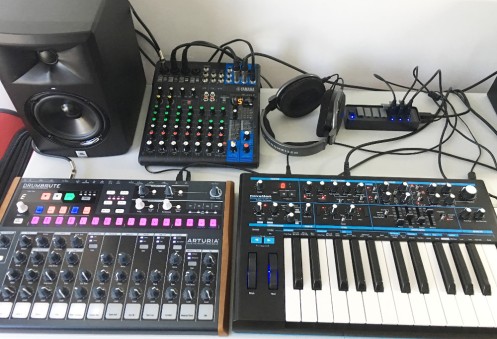(Spread)sheet Music: Making a Simple Music Sequencer using CSV Spreadsheets
On Friday night, I put together a little hack that I found quite amusing. It’s a music sequencer that uses CSV spreadsheets to loop and sequence beats. It has the useful feature that you can save the spreadsheet, and it will periodically reload it, so that you can edit and jam with your sequences live. Best of all, it’s around 100 lines of Python code, comments and all. I posted a video I recorded on twitter, and the reception was very positive, so I thought I would provide a short writeup, and make the source code available as a gist for anyone interested.
You might wonder why I wrote this program, besides the humorous and attention-grabbing aspects. Clearly, there are already a variety of sophisticated programs (DAWs, Digital Audio Workstations) such as Ableton Live out there which can do much more complex things. Part of the motivation is that I like to play with music programming, and by writing my own code to sequence music, I can write a program that will have exactly the workflow and features that I want.
One of the things that I wanted to play with, here, was the ability to create melodies using only the notes in a given scale. Ableton Live Lite, or at least the version I have here, for all its powerful features, doesn’t have a mode that will highlight a given scale (at least not without plug-ins). I think there is a lot of value in being able to write software with an interface that is fully customized for the things you want to play with, and in this case, writing a music sequencer is trivially easy, so why not?

The spreadsheet sequencer uses the mido package to send MIDI output to hardware synthesizers that I have at home, namely a Novation Bass Station II and an Arturia Drumbrute. These are directly connected to my Linux PC using USB. Note that you do not need to own hardware instruments to play with Python and MIDI. I play with hardware synths because I enjoy having physical knobs I can turn, but there are many free software programs that will connect via the MIDI protocol, both synthesizers and samplers.
It’s also possible to use MIDI for input. There are devices called MIDI controllers which can connect to your computer via USB. These can be keyboard, or boards with physical knobs you can turn to adjust parameters as you jam live. You can try searching for MIDI controller on eBay if that’s something that interests you. There are some used ones you can get for very cheap.
To conclude, I will note that although I came up with the idea on my own, I wasn’t the first to think of using a spreadsheet program to sequence music. I hope that this post has encouraged you to explore your musical creativity, or just to program something fun :)
I love the creativity you put into this little project. “Have fun exploring the vast idea space” should be the Programmer’s Motto.
And also not everything has to be an elaborate finished product. It’s interesting to code little experiments with no expectations.
Don’t take this the wrong way, but the rows should be the instrument…
Well, that’s just, like, your opinion maaan.
I did think of having rows as instruments at first, but it seems useful to have the row numbers to count beats in a bar, etc. Spreadsheets are more naturally suited to stretch vertically than horizontally IMO, but if I do eventually program my own UI, I will make it horizontal.
I just assumed you were inspired by the existing tracker interfaces, like MilkyTracker and OpenMPT. From my user experience perspective, having instruments as rows is better, because on modern wide displays you will see larger parts of the track at a time, and you’ll see all the instruments at once 99% of the time.